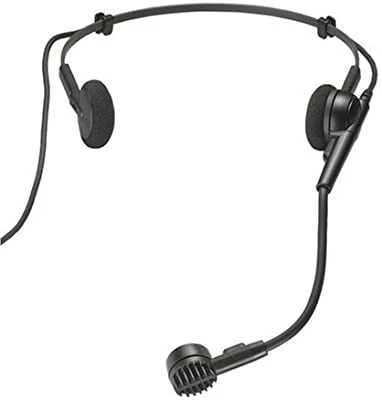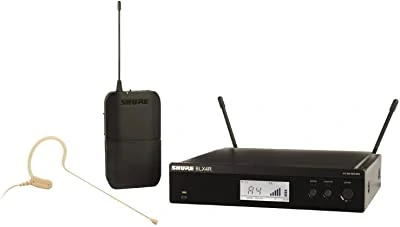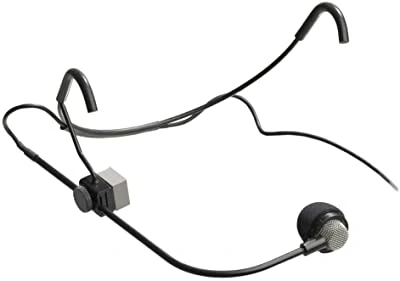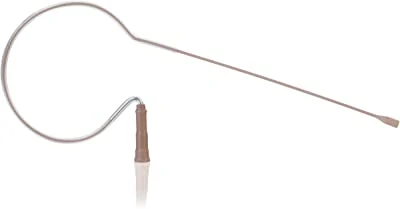Feed Back From My Sm35 Mic
Headset microphones are essential for energetic performances that require hands-free singing. They're ideal for vocalists who also play an instrument, or performers who need complete freedom to move around the stage.
Additionally, a good headset microphone needs to isolate the vocals and reproduce them with maximum clarity. In this definitive guide, I'll present you with a selection of the best headset mics for singing and backing vocals to enhance your performances.
4. Audio-Technica PRO 8HEx

Audio-Technica is another fairly well-known brands in the mic space. They produce high-quality, affordable mics, and the PRO 8HEx is a great example of both of those traits.
While the 8HEx doesn't have the same frequency response as many of the other mics on this list, only 200Hz – 18kHz, the frequency response is still great. The mic is also sensitive enough, able to pick up whispers and not too much clipping at high volumes.
Noise and feedback rejection is also really good on this mic. I didn't notice a whole lot of background noise being picked up by the mic. Considering its price, the 8HEx is an impressive headset mic in terms of sound quality.
The mic comes with a very lengthy 7-foot cable that uses an XLR connector. Audio-Technica clearly intended the PRO 8HEx to be used as a wired mic.
While 7 feet is quite long, it does restrict your movement a bit. You won't be running all over the stage while using one of these mics. The PRO 8HEx is much better suited to drummers, guitarists, bassist, anyone that won't be moving around as much.
Just like the Shure SM35, I was not too impressed by the headset. It is another headset that just sits on top of your ears. The headset has two support pads that sit on either side of your head.
This is supposed to make the headset sit tightly on your head. While it does work in the beginning, the headset starts to slip after a while once you have worked up a bit of a sweat.
The Audio-Technica PRO 8HEx is another great choice for anyone looking for a cheap headset mic. You won't be getting quite the same experience as a mic three times its price, but you are still getting more than you pay for.
PROS
CONS
5. Shure BLX14R/MX53

Shure's BLX14R/MX53 system is the complete opposite of their SM35. This is the high-end, professional-grade system, while the SM35 is a much more consumer-friendly product.
The BLX14R/MX53 is also not just a simple headset mic. Just like the Sennheiser XSW 1-ME3, this is a full wireless system.
It comes with the mic itself, wireless transmitter pack, and receiver unit. The receiver is rack-mountable as well and comes with a rackmount kit.
The receiver can handle up to 12 wireless devices at the same time. Meaning you could effectively connect and entire band's wireless transmitters to the receiver and still have room left for more devices.
The headset is super discreet. It fits over just one ear as opposed to the double ear design of other headsets.
This design makes it very lightweight and non-distracting. That does mean that you will have to take steps to make sure the headset sits securely around your ear to avoid it falling off. Some tape should do the trick.
The mic itself is fantastic. It has a frequency response of 20Hz – 20kHz with a max SPL of 107dB and self-noise of 34dB.
The responsiveness and sensitivity of the mic is great and the audio is crystal clear. The mic also has great noise and feedback rejection.
Of course, a system like this does come at a fairly steep price. The BLX14R/MX53 is among the more expensive systems.
I do think that it is worth the price tag, however. You are getting a high-quality mic and wireless transmitter/receiver system. The system also comes with two convenient carrying cases for the mic and transmitter.
While it is certainly a big initial investment to buy this system, it is one that will more than make up for it in the long run. Especially if you want to expand your wireless setup down the line.
PROS
CONS
6. Crown CM311 AESH

Crown is the sister company of the very popular AKG. You can expect the same high level of quality from Crown as you do from AKG, especially now that all their headset mics are handled directly by AKG.
The CM311 AESH is one of those fantastic, high-quality mics. It has been used by artists such as Phil Collins and Justin Bieber.
One thing that sets the CM311 apart from other headset mics is the way the mic is positioned. Where other headset mics usually sit more to the side of your mouth, the CM311 sits in front of your mouth.
This makes it act more like a normal mic that you sing into. This means that you are getting a much clearer sound and much less background noise.
And I have to say that the CM311 probably has the best noise rejection of any headset mic. You can stand right next to a drummer while they are playing and this mic is going to ignore almost all of the sound coming from the drums.
The CM311 uses a mini XLR connector. This makes it very easy to connect the mic to most wireless bodypacks. The CM311 is actually designed to work with Shure wireless transmitters. So, whether you are a drummer, guitarist, or vocalist, you won't have to struggle with long XLR cables while performing.
I am disappointed with the actual headset. It feels like Crown has just gone with the cheapest and easiest solution here. The headset is just a simple metal wire essentially that barely hangs on your ears.
The headset doesn't sit very firmly and is even a bit uncomfortable. The earpieces actually started to cut into my ears a little after wearing the headset for a while.
While the CM311 is a fantastic mic, I do feel like its price tag isn't quite as justified as the other mics on this list. The mic doesn't come with any extras, a carrying case, or even an extra pop filter.
PROS
CONS
7. Countryman E6

Countryman specializes in small, discreet mics for both vocals and instruments. Their E6 might possibly be the best headset microphone that they currently make.
The Countryman E6 has a lot of clarity and is able to pick up the faintest whisper while also being more than capable of handling loud, booming voices. Noise rejection is also quite good, with the E6 rejecting most ambient and background noise.
The sound isn't perfect out of the box, however. You should always EQ your mics, but I felt like I had to tinker with the EQ a bit more to make sure the E6 didn't sound flat.
The E6 is very thin, light, and discreet. Most people would probably not even be able to see the mic from a distance.
It also sits very comfortably over your ear. But just like any headset that only sits on one ear, I would definitely use some tape just to make sure that it doesn't move or fall off while performing.
What I really like about the E6, and really Countryman in general, is the customization and convenience that they offer. When you buy an E6, you aren't limited to just one configuration.
What I mean by that is that you can choose everything from the pattern of the mic, the connector type, color, sensitivity, and even its flexibility. This lets you choose the perfect setup for your use case.
You can also replace almost any part of the mic should you need to. You can buy new pop filters, clips, even connectors since they are detachable from the actual mic.
The E6 also comes with a very nice, sturdy carrying case. The carrying case has more than enough room for both the mic and any extra cables and attachments you might need.
PROS
CONS
When searching for the perfect headset microphone for your vocals, the main variable that you're likely to come across is the polar pattern. There are three main types used for headset mics: cardioid, hyper cardioid, and omnidirectional.
Cardioid polar patterns are popular choices for headset mics, due to their ability to focus on a singular sound source and minimize any noise coming from the sides.
For drummers who sing or guitarists who are stood close to a loud amplifier, cardioid mic capsules are a great choice.
Hypercardioid mic capsules are less common, but some manufactures prefer them for headset systems.
A variation on the classic cardioid shape, these capsules offer a tighter response at the front of the mic and reduce the outside noise even further. This can sometimes lead to some of the expressions of a singer's voice being compromised slightly.
Finally, omnidirectional capsules are known for their ability to pick up sounds from all angles.
They are used for headset mics because they allow the vocals to be picked up even if the capsule isn't directly pointed towards the singer's mouth, making them ideal for singers who also dance or move around a lot onstage.
Choosing the Right Headset Mic for Singing
All these headset mics are just a handful of the best ones available today. There are many others on the market and the ones listed here might still not be what you are looking for.
So, let us go over some things that you can look out for when choosing the right headset mic for you.
Sound Quality, Noise, and Feedback Rejection
Of course, the first and most important thing you should look at is the sound quality of the mic. You want a mic that is going to be clear, sensitive, and responsive enough.
Just keep in mind that these are headset mics. They won't sound as great as studio mics. If a mic doesn't sound perfect, that is fine. It just needs to sound good for a live performance.
What I do think is more important is the mic's ability to reject background noise and feedback. Since you will be on stage with a bunch of loud instruments, and you might even be playing an instrument, you want a mic that won't pick up all of that extra noise as much.
This is to prevent the background noise from drowning out your own voice. This is especially important so that the mic doesn't pick up the on-stage monitors, creating a terribly annoying feedback loop.
Comfort
The second most important thing in my opinion is how comfortable the headset sits on your head. Since you will likely be wearing the headset for long periods of time, it is important that you are comfortable while wearing it.
The headset should fit tightly around your head while also easily conforming to its shape. It should be tight enough that it doesn't slip or fall off, while also not feeling like it is squeezing your head.
You also don't want a headset that doesn't have any sharp edges that will cut into your ears or head. And you should need as little tape as possible to keep it in place.
Wired vs Wireless
Choosing between a wired headset microphone and a wireless model is really going to be determined by what you do.
Drummers and keyboardists aren't known for running up and down the stage while performing. If you play drums, keyboard, or any stationary instrument while singing, you probably won't need a wireless headset.
Drummers and keyboardists will usually be close enough to a mixing desk or it is easy enough to put a DI box close by. The headset can then just be connected straight into the DI or desk with a long enough cable.
Bassists, guitarists, saxophonists, etc. can go either way. If, for example, you are a guitarist that also uses a headset, but you don't move around that much, you could probably use a wired headset mic.
As long as you make sure to not move too far away from whatever the headset is connected to, you shouldn't run into any troubles. Of course, you will still have another cable hanging behind you that might become distracting.
A vocalist will probably have no other choice but to use a wireless headset. Vocalists are usually the ones running up and down the stage.
The last thing they need is a cable that they can trip over or get tangled. It will also just look a bit awkward if the vocalist is just standing there, but they don't have a mic in their hands or on a stand.
The other downsides of wireless headsets are their limited range and their battery life. Some headsets will have a long range. In which case you won't have to worry about that too much.
Other headsets on the other hand will have a very limited range and will have to stay fairly close to their receivers. If you are only playing smaller venues, theaters, or you can keep the receiver close by, then that is fine.
But if you are going to play big arenas or you can't practically have the receiver close, then you should get a wireless headset with a long range.
And as for battery life, I would just recommend getting a headset with the longest battery life possible. This isn't too big of an issue these days really. Most headsets have a battery life of around 10 hours.
When in Doubt, Look at the Reviews
Everyone's preference differs. Some people might like one product, but then others might hate it. So, there's no such thing as the absolute best headset microphone for singing.
Reviews aren't always helpful or trustworthy, but they can still be a very valuable resource. They are a good way of getting a general consensus about how most people feel about something.
I also find that reviews tend to be much more honest than a sales pitch. People also often point out things that might not be considered by others.
Source: https://musicstrive.com/best-headset-mics-for-singing/
0 Response to "Feed Back From My Sm35 Mic"
Post a Comment